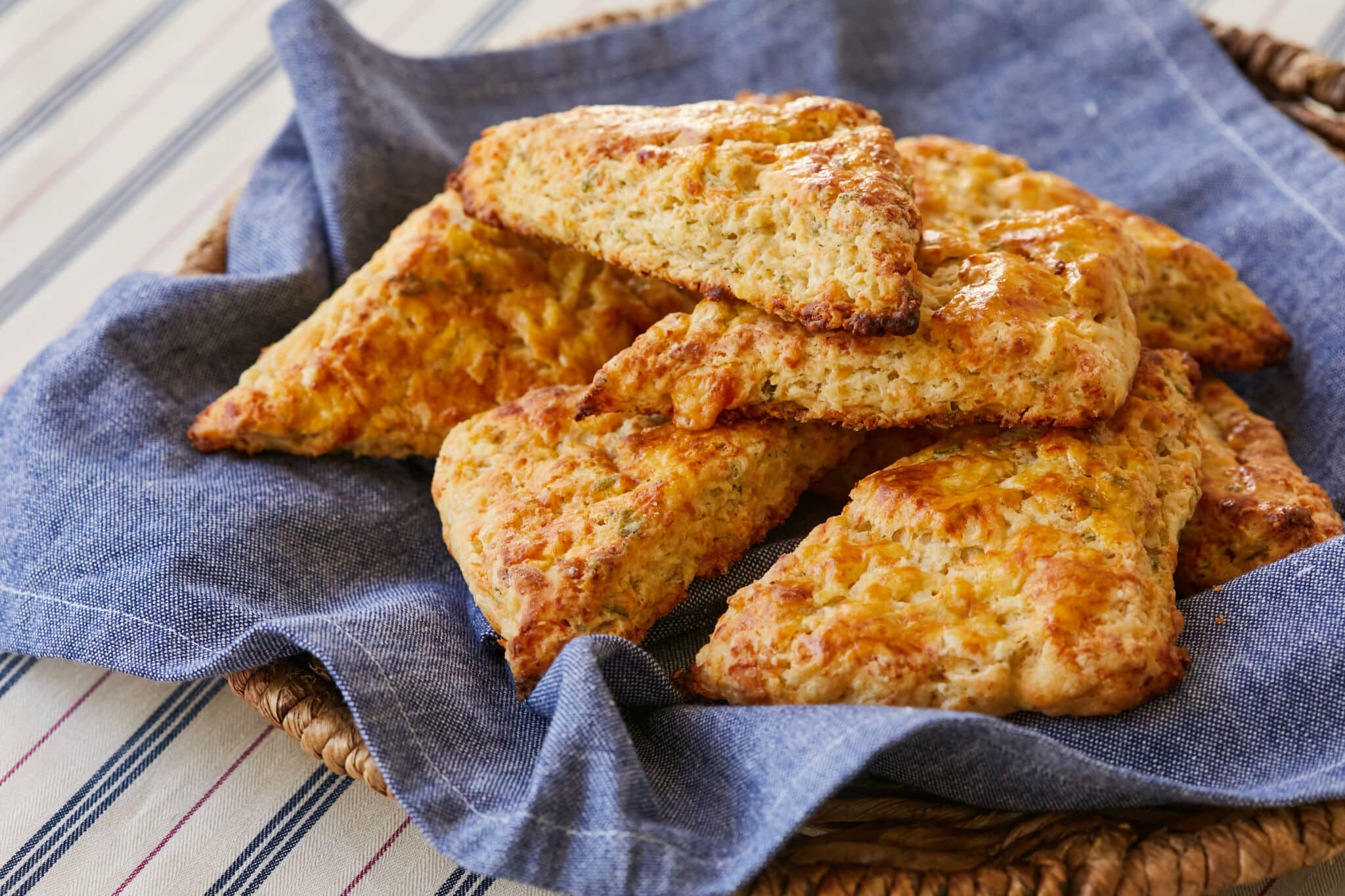
This post may contain affiliate links. Please see my full disclosure for details.
Hi Bold Bakers!
WHY YOU’LL LOVE THIS RECIPE: Apple Sage and Cheddar Scones are tender, savory, subtly sweet quick breads you’ll enjoy again and again for breakfast or an anytime snack with a cup of tea. Bite into the perfectly browned crust and experience a delightfully crumbly interior bursting with juicy apple, melty cheddar, and flecked with earthy sage.
Scones with savory notes are a flavorful change—even though I adore the classic version with raisins, I’m in love with this recipe for perfectly textured scones that taste like autumn!
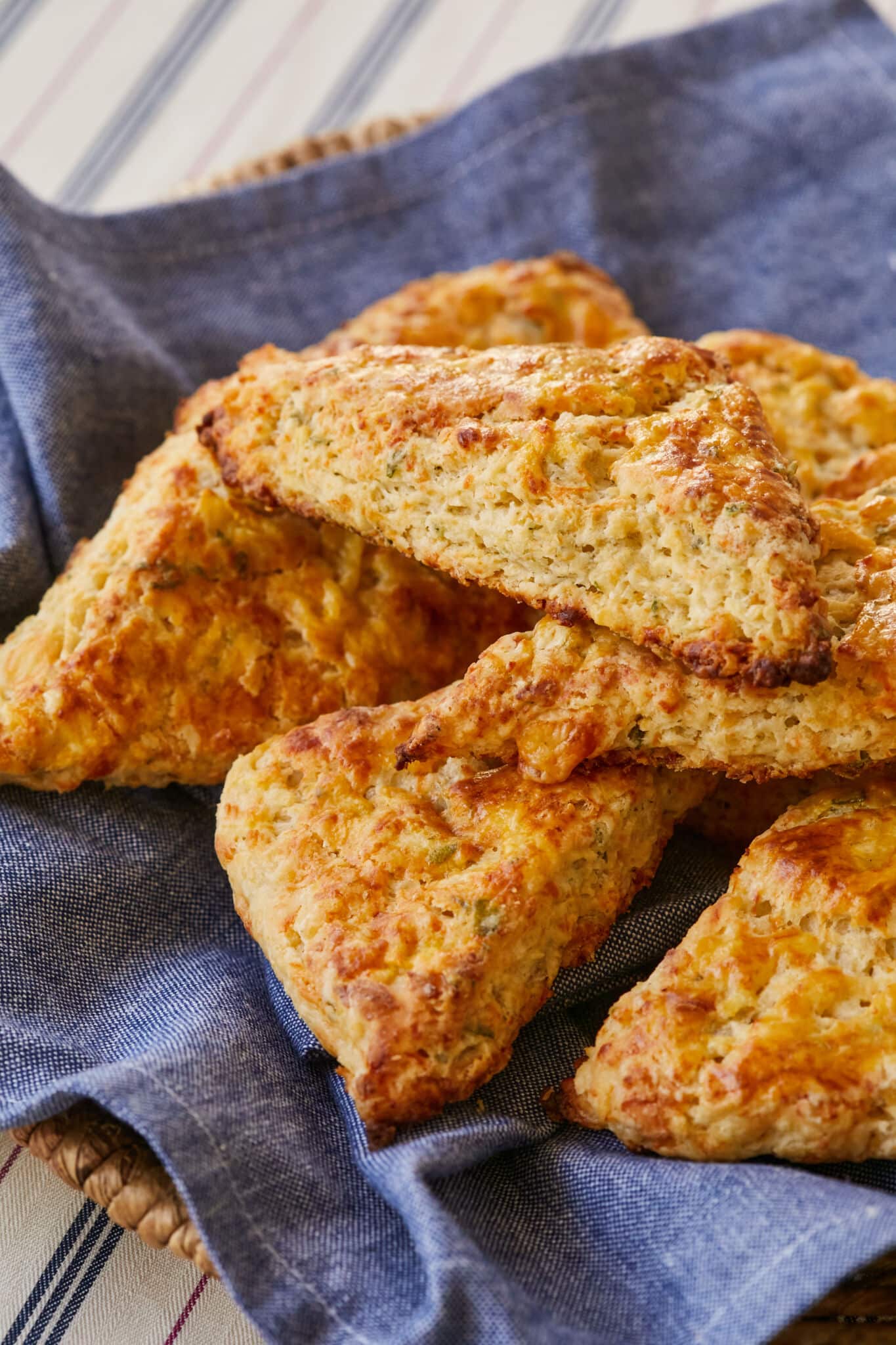
Table of Contents
- What is an Apple Sage and Cheddar Scones?
- Tools You Need to Make Apple Sage and Cheddar Scones
- Key Ingredients and Why
- How to Make Apple Sage and Cheddar Scones
- Can I Make Apple Sage and Cheddar Scones in Advance?
- How to Store Apple Sage and Cheddar Scones
- FAQs
- Gemma’s Pro Chef Tips
- More Scone Recipes
What is an Apple Sage and Cheddar Scones?
- An Apple Sage and Cheddar Scone is a buttery, individually-sized quick bread. Scones are typically light, crumbly, and mildly sweet with a pleasantly crunchy crust and a tender and moist center.
- In this recipe, fruit, cheese, and herbs combine to make a savory scone full of fall flavors. Eat them on their own, with soup, as the base for an egg and cheese breakfast sandwich, or split and fill with turkey or ham, mustard, and lettuce.
- Folks in Ireland and the U.K. have enjoyed scones since medieval times, and early versions were simple oat cakes cooked over an open fire. By the 1800s, the scone developed into the lighter, fluffier modern version we know that is made with wheat flour and baking powder.
- Traditional dried fruit scones like Gemma’s Best-Ever Irish Scones are teatime staples and are typically served with butter, freshly whipped cream or clotted cream, and jam.
Tools You Need to Make Apple Sage and Cheddar Scones
- Mixing bowls
- Measuring cups and measuring spoons
- Grater
- Whisk
- Pastry blender (optional)
- Rolling pin
- Baking sheet and parchment paper
Key Ingredients and Why
-
Heavy Cream
- Heavy cream has a 36% milk fat content. This high percentage gives the scones their distinctive richness and irresistible flavor.
- The abundant fat from heavy cream not only adds moisture to scones, but also coats the flour particles, inhibiting the gluten formation. This results in a more delicate and crumbly texture.
-
Baking Powder
- Once mixed with liquid, baking powder causes a quick chemical reaction that creates carbon dioxide, creating bubbles in the batter and forming an airier crumb and a tender, lovely crumbly texture.
- Learn How to Make Baking Powder and Baking Soda Explained and you’ll always be prepared to make scones and other treats.
-
Egg
- Egg provides protein to bind the ingredients together and form a cohesive structure.
- Eggs also add moistness and rich flavor to the scones.
-
Butter
- Butter is key to a scone’s scrumptious flavor and special texture.
- Be sure to use cold butter. As it melts during baking, the resulting steam makes pockets that create a flaky, tender texture.
- Making your own is easier than you think! Check out my post How to Make Homemade Butter.
-
Granny Smith Apples
- Granny Smiths are definitely my preference, as they are tart, tangy, and mildly sweet, and are crisp and won’t go mushy.
- Bramley apples will be your go-to cooking apples in Ireland or UK, which are very sour to eat but work beautifully in baking, such as Apple Crumble.
- Using grated apples instead of apple chunks permeates the scones with their flavor.
-
Sharp Cheddar Cheese
-
Fresh Sage
- The complex, savory flavor and aroma of sage elevates the apple and cheddar flavors and gives the scones extra depth and warmth.
- Fresh sage is best, but if you are using dry, the substitution rule is to use 1/3 the amount of dried herbs for fresh, or 1tsp (about 2g) of dried herbs for 1 tbsp of fresh herbs.
How to Make Apple Sage and Cheddar Scones
- Mix wet ingredients: Grate apples and squeeze out excess moisture. Squeezing the liquid out of the apples before adding them to your mixture ensures the batter won’t be too watery. Whisk with cheese, milk, and egg.
- Mix dry ingredients: In a separate bowl, whisk flour, baking powder, and salt.
- Rub the butter into the flour: Do this until the mixture resembles coarse bread crumbs. This technique distributes the butter thoroughly to yield a uniform batch of scones. Additionally, it coats the flour with fat, preventing the formation of gluten that would make the scones tough.
- Combine: Add the wet ingredients and knead the dough together lightly until just blended. Do NOT over-mix.
- Shape: On a lightly floured surface, roll out into a 6-inch (15 cm) circle and cut into 8 wedges.
- Bake: Brush with egg wash and bake for 30 minutes, until golden brown. Serve warm.
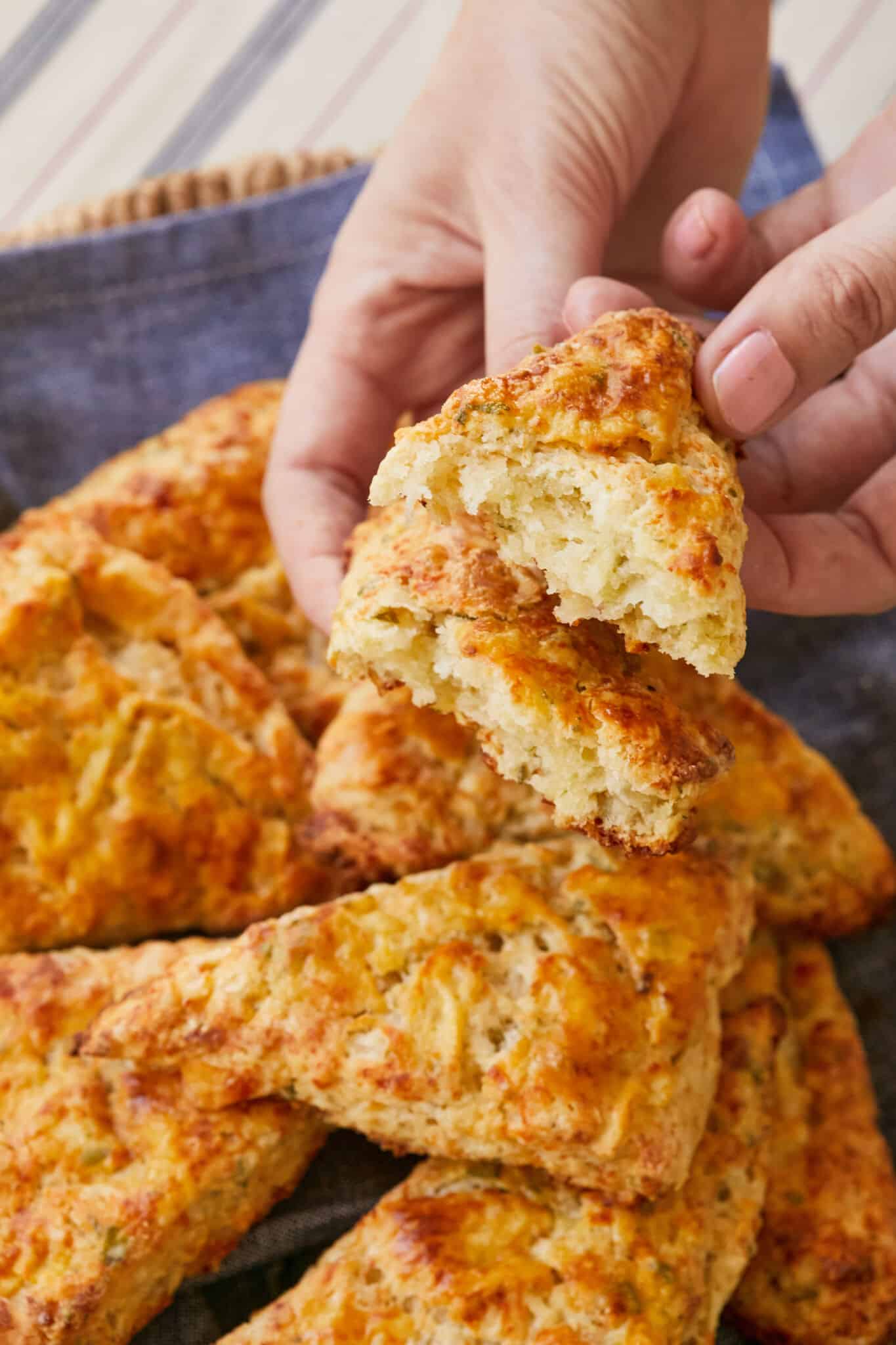
Can I Make Apple Sage and Cheddar Scones in Advance?
I recommend mixing up Apple Sage and Cheddar Scones right before baking for two reasons:
- Baking powder gets activated the moment it’s mixed with wet ingredients so leaving the mixture too long will yield a dense result.
- Also, the apple in the batter could brown if mixed in advance.
How to Store Apple Sage and Cheddar Scones
- Store leftover scones in an airtight container at room temperature for up to one day or in the refrigerator for up to 3 days. You can also freeze for up to three months.
- Rewarm in a 300°F (150°C) oven for 10 minutes.
FAQs
-
What’s the difference between scones and biscuits?
-
Can I make Apple Sage and Cheddar Scones without eggs?
- In scones, where eggs are a leavener, “vinegar and baking soda” or “oil, water, and baking powder” can produce carbon dioxide to make baked goods rise. These are shelf-stable or pantry staples.
- See our 12 Best Baking Substitutes for Baking Recipes & How to Use Them for more information.
-
Can I make Apple Sage and Cheddar Scones gluten-free?
- Yes, you can use almond flour or gluten-free 1:1 flour from my Guide to the Best Gluten-Free Flours and my recipe for Homemade Gluten Free Flours.
- For store-bought options, both Bob’s Red Mill and King Arthur Flour make wonderful gluten-free all-purpose flour.
-
Why are my scones tough and dry?
There are several things to look out for:
-
- First, make sure your baking powder is fresh.
- Second, different flours absorb liquid differently. That’s why a good rule of thumb Note to hold back some liquid by using up to 3/4 in one go and adjust it accordingly to get the same consistency as the recipe.
- Third, this is leavened with baking soda or baking powder or both which doesn’t need yeast to build up gluten. So do not over mix which will cause strands of gluten to make it hard to rise. Make sure all ingredients are at room temperature. Bring ingredients together until just combined.
-
Can I use another herb in place of sage?
Although the scones won’t be exactly the same, thyme or marjoram would be good substitutes for sage
Gemma’s Pro Chef Tips
- To make egg wash, beat one egg with 1 tablespoon of milk or water or just use the leftover wet ingredients in the bottom of the jug.
- If you don’t have a pastry blender to add the cold butter to the flour mixture, massage the butter into the dry ingredients with a fork. Do NOT over mix.
- Using frozen butter is a great way to create pockets of butter throughout and adds loads of air and texture to the finished scones. Here’s how: In one bowl, grate frozen butter into the flour.You can also do this whenever you have time and freeze the butter curls.
- While mixing the ingredients, set your strong hand ready into a “claw shape” to pull your dough gently around (watch the video of my best-Ever Scones Recipe to see details), in order to get a light and airy result instead of an overly dense and toughened one. Add in more liquid as needed JUST until the dough comes together and forms a ball.
- You can freeze individual raw scones after they’re cut out. When it’s time to bake, take them out of the freezer to defrost at room temperature for 10 to 15 minutes. Bake at 375°F (190°C) for roughly 30 minutes or until golden brown all over.
More Scone Recipes
Apple, Sage and Cheddar Cheese Scones Recipe
Ingredients
- 3 medium granny smith apples, peeled and grated (about 16oz/454g)
- 1 cup (3 oz/85 g) sharp cheddar cheese, grated
- ¼ cup (2 fl oz/60 ml) heavy cream, cold
- 1 egg, cold
- 2 tablespoons fresh sage leaves, minced
- 1 ½ cups (7½ oz/213 g) all-purpose flour
- 1 ½ teaspoons baking powder
- ½ teaspoon salt
- 6 tablespoons (3oz/85g) butter, cold and diced
- Egg wash
Instructions
- Preheat the oven to 375°F (190°C). Line a baking sheet with parchment paper and set aside.
- Squeeze any excess liquid out of the grated apples and place them in a medium bowl along with the cheese, heavy cream, and egg. Whisk together and set aside.
- In a separate large bowl, combine the flour, baking powder, and salt.
- Rub the cold butter between your thumb and fingers to incorporate the butter into the flour. Do this until your mix resembles coarse breadcrumbs. (You can also do this step with a pastry blender)
- Pour the wet ingredients into the flour mixture and, working quickly, lightly knead the mixture just until it comes together.
- Gather into a ball, transfer to a floured surface and roll out to a 6-inch (15 cm) circle, roughly 1¼-inch (3 cm) thick.
- Cut the disc into 8 wedges, transfer to the parchment-lined baking sheet and brush the tops with egg wash.
- Bake until the scones are golden, about 30 minutes. Let cool for about 10 minutes before serving.
- Serve warm from the oven. Store leftover scones in an airtight container at room temperature for up to one day or in the refrigerator for up to 3 days. Rewarm in a 300°F (150°C) oven for 10 minutes.
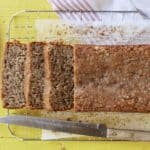
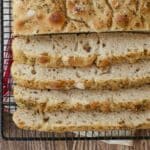
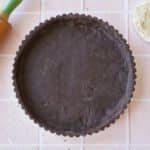



Hi Gemma, would pulsing small cubes of butter into the flour with a food processor be similar to massaging the butter into the flour? I don’t have a pastry blender but feel a little lazy to massage the butter too (if I’m being honest… lol)
Hi Gemma,
Can I use dried sage here? If so, how much would you recommend?
Thank you!
hi .can we substitute the eggs in this recipe? and what is the substitute of sage.as I don’t get it where I live.Thanks